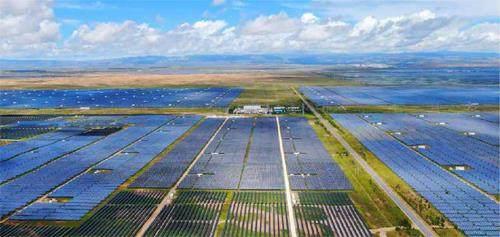塔拉滩的蓝、绿、白
黄蕾



塔拉灘,位于青海省海南藏族自治州共和县。这里地广人稀,平均海拔在2 900 米左右,年均日照时长达3 000 小时,曾是黄河上游风沙危害最严重的地区之一,土地荒漠化率高达98.5%。由于其海拔高、日照时间长,所以是利用太阳能发电的理想区域。
Talatan, situated in Honghe County, Hainan Tibetan Autonomous Prefecture within QinghaiProvince, China, is known for its expansive land and sparse population. Sitting at an average altitude ofaround 2,900 meters, it receives approximately 3,000 hours of sunlight annually. Historically, it grappledwith severe wind and sand hazards in the upper Yellow River basin, with desertification rates soaring upto 98.5%. Yet, its high altitude and abundant sunlight also make it an excellent location for harnessingsolar energy.
2012 年,中国耗资3 亿人民币在塔拉滩建造了一座光伏发电园区—青海省海南州太阳能生态发电园区,也称“塔拉滩光伏发电园区”。园区最初建设面积77.9 平方公里,后扩建至609 平方公里。这是中国首个千万千瓦级太阳能生态发电园,也是目前全球一次性投入最大、单体容量最大、集中发电规模最大的光伏电站群。
In 2012, China made a substantial investment of300 million RMB to establish a photovoltaic powergeneration park in Talatan, which gave birth to theQinghai Hainan Prefecture Solar Power Park, alsoknown as the “Talatan PV Power Park.” Initiallyspanning 77.9 square kilometers, the park has sinceexpanded to cover 609 square kilometers. It is China’sfirst solar eco-power park, boasting a capacity often million kilowatts. It also holds the distinctionof being the world’s largest cluster of photovoltaicpower stations, evaluated based on single-installmentinvestment, individual unit capacity, and overall powergeneration scale.
站在高高的瞭望塔上极目远眺,成片的光伏板一望无际,绵延不断,宛如一片“蓝色海洋”。
From a high vantage point on anobservation tower, one can behold aninfinite array of photovoltaic panelsstretching toward the horizon, resemblinga vast panorama of “blue ocean.”
光伏发电的原理是利用大量光伏板吸收太阳能,再将太阳能转化成电能。光伏发电有很多优点,如低成本、无噪声、无毒害、易安装、可再生等。但是,在一片荒漠之中建造大型发电园区也非易事。
Photovoltaic power is generated using solar panelsthat absorb sunlight and convert it into electricity. Thismethod is cost-effective, environmentally friendly,quiet, non-toxic, and relies on renewable energysources. However, building a large solar power park inthe middle of a desert is by no means an easy task.
在塔拉滩光伏发电园区建立之初,工作人员就遇到了重重困难。首先是风沙。由于当地风沙大,光伏板很容易被大量的尘土覆盖,光电转化效率会因此降低,只能人工从36 公里外的黄河河道中取水清理。但令人没想到的是,原本用来清理板材的水,流入了荒芜的土壤,加上太阳能板的遮挡,土壤蒸发率降低,在一片片光伏板之下,土地竟萌发出了绿茵,不久就形成了一片草原。“蓝色海洋”和绿色草原交相辉映,令人无限欣喜。
Initially, several obstacles were encountered, with the primary one beingfrequent sandstorms that covered the solar panels with a thick layer of dust,reducing their efficiency in converting sunlight into electricity. The nearestfeasible solution was to fetch water from the Yellow River, located 36 kilometersaway, to clean the panels. Interestingly, the water used for cleaning also hada positive effect on the barren soil, reducing its evaporation rate due to theshading provided by the solar panels. This led to the growth of lush greeneryunderneath, transforming the site into a harmonious combination of theexpansive “blue sea” of solar panels surrounded by green landscapes, andcreating a delightful view.
然而新的问题也来了,生命力顽强的小草开始野蛮生长,很快就要超过光伏板的高度。一方面,草遮盖光伏板会降低光电转化效率;另一方面,冬季枯萎的草很容易引发火灾,这种情况一旦发生,将造成巨大的损失。这时,有人想到让羊来吃草—对牧民而言,这样降低了饲料成本;对园区而言,草势得到控制的同时,也不用增加人工费;对整个生态环境而言,羊粪又可以肥沃和优化土壤、滋养草场,可谓一举多得。于是,工作人员在600 多平方公里的光伏区域搭建了四个羊圈,羊儿们在这里自由自在散步、大口大口吃草,好不惬意!这群特殊的羊被称为“光伏羊”,而在这儿放羊的牧民也被称为“光伏羊倌”。
However, new challenges emerged as the resilient grassunderneath the solar panels began to grow uncontrollably,posing a threat to the panels and their photovoltaicefficiency. During the winter, this dry grass became afire hazard, increasing the risk of damage. An innovativesolution was devised to address this issue by using sheepto manage the grass growth. This not only reduced feedingcosts for herders but also maintained the park withoutadditional labor expenses. Additionally, it improved theecosystem by naturally fertilizing the soil through sheepdung. Consequently, four sheep pens were establishedacross the vast 600 square kilometers of the photovoltaicarea, allowing the sheep to graze freely. These uniquecreatures are affectionately referred to as “PV sheep” andare cared for by a group of “PV shepherds.”
2022 年,塔拉滩光伏发电园区年产牧草11.8 万吨,“光伏羊”的出栏量达到5 万只。在每只“光伏羊”的耳朵上,都悬挂着2 厘米见方的耳标,那是羊的“身份证”。一扫耳标上的二维码,就能查到该羊的月龄、养殖户、疫苗注册等信息,消费者能买得更放心。给牧民带来了收益、为园区解决了实际问题的“光伏羊”,也成为海南州人民的“团宠”。 2023 年是青海省海南藏族自治州成立70周年,庆祝的吉祥物“南小阳”就是根据“光伏羊”设计的。“南小阳”身着藏族服装,脚踏草地,背靠光伏板,十分惹人喜爱。
In 2022, the park produced 118,000 tons of forageand fostered a population of 50,000 “PV sheep.” Eachsheep is identifiable through a 2-square-centimeter eartag that contains a QR code. Consumers can scan thisto access vital information about the sheep’s age, theirherders and vaccination records, promoting transparencyand confidence in purchase. This initiative has not onlybolstered the income of local herders and resolvedpractical challenges within the park but has also turned these sheep into a cherished symbol for the people of Hainan Prefecture. In 2023,as the Hainan Tibetan Autonomous Prefecture celebrated its 70th anniversary, theconcept of “PV sheep” inspired the design of the celebration’s official mascot —“Nan Xiaoyang.” “Nan Xiaoyang” dons traditional Tibetan attire and is setagainst a backdrop of grasslands and photovoltaic panels, making it exceptionallyendearing.
如今,海南州已在園区内建成10 个光伏生态牧场,可养殖近八万只羊,年均增收6 000余万元,形成了“光伏产业 + 生态保护 + 生态农牧业”的融合发展新模式。
Today, Hainan Prefecture has successfully set up 10 PV eco-ranches withinthe park, providing a home for nearly 80,000 sheep. With the annual increase inrevenue by over 60 million RMB, the park has set up a sustainable model thatharmoniously combines the photovoltaic industry with ecological conservationand animal husbandry.
在塔拉滩光伏发电园区人多年不懈的努力下,海南州清洁能源装机容量达4 314 万千瓦,其中光热35 万千瓦、水电736 万千瓦、抽水蓄能910 万千瓦、光伏2 103 万千瓦、风能530万千瓦,完成并网装机2 094 万千瓦(占青海省装机容量的52%),在建2 220 万千瓦。园区新能源不仅能够满足青海省内的需求,多余的还会输送到其他省份。2020 年,中国首条清洁能源特高压输电线路青海—河南±800 千伏特高压直流工程正式投运。青海的绿电直接供给1 500 公里之外的河南。通往江苏的输电通道建設已获批并进入前期准备工作,通往港珠澳的外送输电通道正在谋划当中。2022 年,海南州光伏发电园区与龙羊峡水光互补发电站正式获得吉尼斯世界纪录认证,分别成为全球最大装机容量的光伏发电园区和最大装机容量的水光互补发电站。
Through the park’s steadfast dedication, HainanPrefecture has achieved a clean energy with a totalinstalled capacity of 43.14 million kilowatts. Thisincludes 350,000 kilowatts of solar thermal power,7.36 million kilowatts of hydropower, 9.1 millionkilowatts of pumped storage, 21.03 million kilowattsof photovoltaic power, and 5.3 million kilowatts ofwind power. The park’s completed grid-connectedcapacity is 20.94 million kilowatts, which accountsfor 52% of Qinghai Province’s total installedcapacity. An additional 22.2 million kilowattsof capacity is under construction. Remarkably,the park not only satisfies new energy demandsof Qinghai Province but has initiated the exportof surplus energy to other provinces. In 2020, amilestone was achieved with the launch of China’sfirst clean energy ultra-high-voltage transmissionline — the Qinghai-Henan ±800 kV ultra-highvoltagedirect current line. This project facilitatesthe direct transfer of green electricity from Qinghaito Henan, located 1,500 kilometers away. Furtherexpansions are underway, with preparations for a transmission channel to Jiangsu, and plans beingdrawn up for channels extending to Hong Kong,Macau, and Zhuhai. In 2022, the Talatan PVPower Park and the Longyangxia HydropowerStation officially received the Guinness WorldRecords certification, becoming the world’s largestphotovoltaic power park and the largest hydrosolarhybrid photovoltaic power station in terms ofinstalled capacity respectively.
昔日黄沙漫天的戈壁荒漠早已改变了模样,绵延的草地上整齐搭建着蓝色光伏板,一眼望不到边,羊群穿梭其间,编织出一条独特的蓝绿白三色高原生态风景线。
What once was a barren desert, characterizedby relentless winds and blowing yellow sand,has transformed. Now, vast grasslands stretch tothe horizon, adorned with neatly arranged bluephotovoltaic panels. Amidst this landscape, herdsof sheep roam freely, creating a unique highlandscenery of blue, green, and white.

